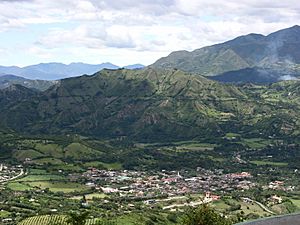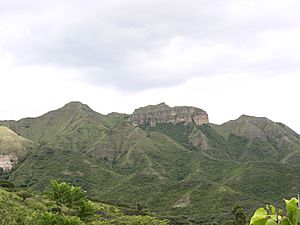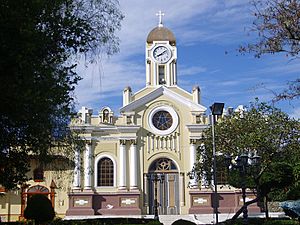Vilcabamba, Ecuador facts for kids
Vilcabamba is a small village located in the southern part of Ecuador. It's in the Loja Province, about 45 kilometers (28 miles) from the city of Loja. The name ‘Vilcabamba’ comes from the Quichua language. Huilco means the sacred trees, Anadenanthera colubrina, that grow there, and pamba means ‘plain’ or ‘valley’.
This area was once known as the ‘Playground of the Inca’. This is because it was a special place where Incan royalty would go to relax. A mountain called Mandango, which looks like a sleeping Inca, overlooks the valley. People believe this mountain protects the area from earthquakes and other natural disasters.
Contents
The Secret of Long Life
Why People Thought Residents Lived Longer
Vilcabamba is a beautiful valley that attracts many tourists. A big reason for this is the widespread belief that the people living there become very old. Locals often say it's common for people to live to be 100 years old. Some even claimed that many residents reached ages like 120 or even 135. If true, this would make it a place with some of the oldest people on Earth. Because of these stories, it was often called the Valley of Longevity, meaning the valley of long life.
In 1973, a doctor named Alexander Leaf from Harvard Medical School wrote a story about these people for National Geographic Magazine. This made Vilcabamba famous around the world.
Doubts About the Claims
However, not everyone believed the stories about extreme old age in Vilcabamba. According to a book by Peter Laslett, claims about people living to very extreme ages are often not true. He said that while some places might have healthier people, it doesn't mean they live much longer than everyone else.
Some experts suggested that the long lives in Vilcabamba were simply due to a healthy lifestyle. This included lots of exercise, a good diet, and the community taking good care of its older members. Another idea was that younger people moved away to cities, leaving a higher percentage of older people behind.
Checking the Ages of Residents
As Vilcabamba became more famous, scientists continued to study the secret of the villagers' long lives. But some, including Dr. Alexander Leaf, started to have doubts. Dr. Leaf became suspicious when he noticed that villagers often gave different ages for themselves. For example, in 1971, he met a man who said he was 122 years old. When Dr. Leaf returned three years later, the same man claimed to be 134 years old!
Dr. Leaf then asked other researchers, Dr. Richard Mazess and Dr. Sylvia Forman, to help find the true ages of Vilcabamba's older residents. They found that there was not a single person over 100 years old living in Vilcabamba. The oldest person they found was 96 years old. On average, people who claimed to be over 100 were actually around 86 years old. These findings were shared in 1978.
The researchers concluded that people in Vilcabamba did not live longer than people in other parts of the world. In fact, they found that life expectancy in Vilcabamba was actually a bit lower than in the United States.
What We Learned
Even though the people of Vilcabamba didn't live longer than others, researchers still noted something important. The Vilcabamba lifestyle seemed to keep the villagers very healthy and strong as they got older. This lifestyle included hard work at a high altitude, along with a diet that was low in calories and animal fats.
Climate
| Climate data for Vilcabamba/Malacatos, elevation 1,600 m (5,200 ft), (1961–1990) | |||||||||||||
|---|---|---|---|---|---|---|---|---|---|---|---|---|---|
| Month | Jan | Feb | Mar | Apr | May | Jun | Jul | Aug | Sep | Oct | Nov | Dec | Year |
| Mean daily maximum °C (°F) | 27.7 (81.9) |
27.8 (82.0) |
27.7 (81.9) |
28.1 (82.6) |
28.5 (83.3) |
27.5 (81.5) |
27.2 (81.0) |
27.7 (81.9) |
28.3 (82.9) |
28.6 (83.5) |
29.0 (84.2) |
28.7 (83.7) |
28.1 (82.5) |
| Daily mean °C (°F) | 20.7 (69.3) |
20.7 (69.3) |
20.7 (69.3) |
20.7 (69.3) |
20.5 (68.9) |
20.2 (68.4) |
20.2 (68.4) |
20.5 (68.9) |
20.8 (69.4) |
21.0 (69.8) |
21.2 (70.2) |
21.1 (70.0) |
20.7 (69.3) |
| Mean daily minimum °C (°F) | 14.5 (58.1) |
14.6 (58.3) |
14.3 (57.7) |
14.3 (57.7) |
13.1 (55.6) |
12.6 (54.7) |
12.5 (54.5) |
12.6 (54.7) |
12.6 (54.7) |
13.1 (55.6) |
13.0 (55.4) |
13.6 (56.5) |
13.4 (56.1) |
| Average precipitation mm (inches) | 60.0 (2.36) |
87.0 (3.43) |
125.0 (4.92) |
103.0 (4.06) |
29.0 (1.14) |
21.0 (0.83) |
11.0 (0.43) |
15.0 (0.59) |
26.0 (1.02) |
59.0 (2.32) |
54.0 (2.13) |
61.0 (2.40) |
651 (25.63) |
| Source: FAO | |||||||||||||
See also
 In Spanish: Vilcabamba (parroquia de Loja) para niños
In Spanish: Vilcabamba (parroquia de Loja) para niños




